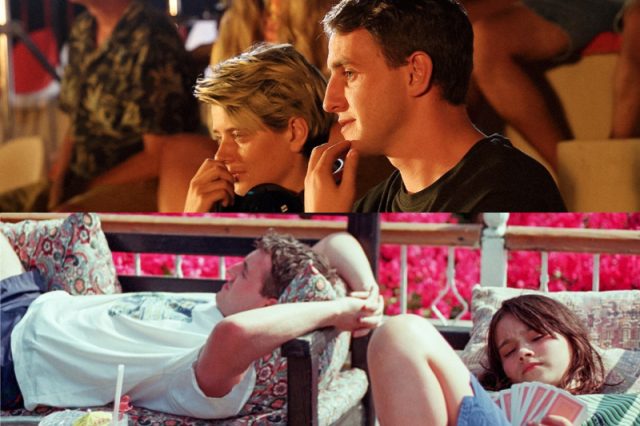As author C.S. Lewis wrote in A Grief Observed (1961): “In grief nothing ‘stays put’.” For Lewis, grief is not a linear process, but recurrent, cyclical and never truly complete. “Everything repeats,” he writes. “Am I going in circles, or dare I hope I am on a spiral? But if a spiral, am I going up or down it?”
Lewis’s metaphor is an apt description for director and writer Charlotte Wells’ award-winning film Aftersun (2022). About returning from and returning to our past, Aftersun is a product of memory and an unfolding act of remembrance. The film’s events happen in the past tense, but as critic Daniel Drake observed in The New York Review of Books, it also captures what it is to be stuck in an imperfect present.
Wells’ film explores the relationship between young father Calum (Paul Mescal) and his daughter Sophie (Frankie Corio), who are holidaying together at a Turkish resort sometime in the late 1990s. Audiences first see the pair through grainy video camera footage which is interspersed throughout the film as they document their trip.
As the film progresses, we slowly begin to realise that Calum’s camera is capturing lasts rather than firsts. At the end of the holiday, when Sophie leaves on a Scotland-bound plane, it marks the last time they will see each other.
Years later, an adult Sophie (Celia Rowlson-Hall) watches the footage – the camera connected by a lead to a TV in the living room of her New York apartment. She reconnects and reckons with her younger self, frozen on screen as she waves goodbye to her father behind the camera.
It’s clear from how that footage is cut throughout the film that this isn’t the first time Sophie is watching. Maybe she’s lost count. She watches, rewinds, pauses. We hear and see the mechanics of this: the low drone of the tape, the click indicating the beginning of the footage, glitches in the blue-tinted, grainy images, springing into life from a black screen.
For the audience – and for Sophie – the distance between past and present is blurry. The tapes become a conduit, bringing Calum back, though only momentarily. What were once mundane discussions and rambling observations are now imbued with a value that only increases over time.
Just like grief, this is a story that never truly resolves itself. It’s never explicitly stated what happens to Calum. The film is filtered mostly through Sophie’s perspective, so our knowledge of him is limited by her own understanding, or by what Calum chooses to show her.
There are significant exceptions to this when Calum is alone, such as the moment when he breaks down in the hotel room, far from young Sophie’s sight. These, coupled with other small clues, placed throughout the narrative – such as his broken arm and a general disregard for his own safety – signals that he’s struggling with something he cannot or dare not name. This is the Calum that adult Sophie will never know or understand, no matter how many times she rewinds the tape, searching for clues.
Grief casts a shadow over Sophie’s life. Many people watching will already know the shape and the weight of the grief she carries. For Wells, the intense and personal emotional reactions the film were a shock, an unintended consequence of exorcising her grief for her own father.
The meaning of Aftersun’s Under Pressure sequence
Central to Aftersun’s emotional power is the Under Pressure sequence, in which Sophie and Calum dance together on their last night at the resort.
The scene functions as a kind of emotional and narrative crescendo. Throughout the film, there are scenes of adult Sophie encountering Calum dancing at a rave. These moments exist somewhere outside of her everyday life. She calls out to him but can’t be heard over the loud music. Often he cannot be seen, obscured by the dark or the strobe lights. The Under Pressure sequence unites the film’s two settings – Turkey and the rave – and cuts between them.
The Queen and David Bowie duet was brought in by Wells to replace a temporary track that she had been using to build the film’s first cut. In a recent interview, she explained that when she hit play, Under Pressure: “lined up at exactly the perfect point”.
Aftersun is not the first film to use the song, but it is the first one to use it in this form. Here, remixed, bridging the time and space between Turkey and the rave, the synth and strings signature of Oliver Coates’ score are combined with the isolated vocals of David Bowie and Freddie Mercury to haunting effect.
Only during the Under Pressure dance do these formerly unexplained scenes, these quasi-nightmarish intrusions, make sense, slotting in as the last puzzle piece of Sophie and Calum’s story. Only here, does adult Sophie finally reach her father, dressed as she remembers him in the airport departure lounge, unchanged.
Angry, resentful, she beats at his chest, just as her younger self playfully resists her father’s embrace on the Turkish dance floor. Finally, there’s no resistance, younger and older Sophie embrace Calum, as Freddie Mercury’s vocals soar, imploring us to “give love”.
Adult Sophie’s peace doesn’t last. Too soon, Calum slips from her grasp, sinking into the darkness, lost in the turn of the strobe. Sophie is alone once more in the dark of the rave. Wells’ script conveys this moment with spare devastation: Calum is gone. Through song and dance, though, Calum can return and Sophie can hug her father once again. Music lends her the power to transcend – and momentarily pause in – her spiral of grief.![]()
Leanne Weston, Associate teaching fellow, Film and Television Studies, University of Warwick. This article is republished from The Conversation under a Creative Commons license. Read the original article.










